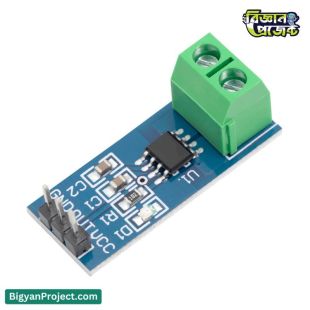- English
- বাংলা
-
 Science Projects
Science Projects
-
 Sensor & Modules
Sensor & Modules
-
 Basic Components
Basic Components
-
 Development Boards
Development Boards
-
 Robotic Parts
Robotic Parts
-
 Drone Parts
Drone Parts
-
 Tools & Accessories
Tools & Accessories
-
 Power Sources
Power Sources
-
 Kits & Combo
Kits & Combo
-
 IC & Microchip
IC & Microchip
-
 Cables & Connectors
Cables & Connectors
-
 Audio Components
Audio Components
-
 Our Services
Our Services
Current Sensor
Accurately measure electrical current in your circuits with our range of current sensors. These components are essential for projects that require monitoring power consumption, controlling motors, or creating overload protection systems for safety.
There is 1 product.
Measure and Master Electricity with Current Sensors in Bangladesh
Welcome to the Current Sensor category at Bigyan Project! If you're a student working on a science project, a university researcher, or a DIY hobbyist in Bangladesh, you know how crucial it is to understand and control electricity. A current sensor is an essential tool that acts like a meter for electricity, allowing you to see exactly how much electrical current is flowing through a circuit. It’s a game-changer for any project, from a simple LED circuit to a complex robot.
What Exactly is a Current Sensor?
Think of an electrical wire like a water pipe. You can see the pipe, but you don't know how fast the water is flowing without a meter. A current sensor does the same thing for electricity. It measures the flow of current (measured in Amperes or Amps) without interrupting the circuit. This data can then be read by a microcontroller like an Arduino, ESP32, or Raspberry Pi, giving your project the ability to make smart decisions based on power usage.
Why Your Next Project Needs a Current Sensor
Integrating a current sensor into your electronics project opens up a world of possibilities. At Bigyan Project, we've seen students and creators use them for amazing applications. Here’s why you need one:
Monitor Power and Battery Life
For any battery-powered project, like a portable device or robot, knowing how much power is being consumed is critical. A current sensor helps you accurately monitor battery usage, predict remaining battery life, and even create low-power modes to make your project last longer.
Protect Your Motors and Components
Motors can sometimes draw too much current, especially under heavy load. This can cause the motor to overheat and damage itself or other parts of your circuit, like the motor driver. By using a current sensor, your microcontroller can detect an overcurrent situation and shut the motor down before any damage occurs. This is a must-have safety feature for any robotics project.
Build Smart and Responsive Devices
Imagine a smart charger that stops charging when the battery is full, or a system that texts you when an appliance starts using more power than usual. These "smart" features are made possible by monitoring current. You can build intelligent, safe, and efficient devices by simply adding a reliable sensor from our collection.
Popular Types of Current Sensors Available at বিজ্ঞান প্রজেক্ট
Choosing the right sensor can seem confusing, but it's easy once you know the main types. We stock the most reliable and project-friendly sensors for students in Bangladesh.
Hall Effect Current Sensors (like the ACS712)
The ACS712 is one of the most popular sensors for hobbyists. It uses the Hall Effect to measure current, which means it's electrically isolated from the circuit you're measuring. This makes it very safe and easy to use. It can measure both AC and DC current and comes in different versions (5A, 20A, 30A) to match your project's needs.
Shunt Resistor-Based Sensors (like the INA219)
For high-precision measurements, the INA219 is an excellent choice. This sensor measures the tiny voltage drop across a very precise resistor (a shunt resistor). It's incredibly accurate and can measure both voltage and current, allowing you to also calculate power. It communicates using I2C, making it easy to connect to almost any microcontroller.
How to Choose the Right Sensor for Your Project
To select the perfect current sensor from Bigyan Project, consider these key points:
- Current Type: Do you need to measure AC (like from a wall socket) or DC (like from a battery)? The ACS712 can often do both, while others are DC-only.
- Maximum Current: What is the highest current you expect in your circuit? Choose a sensor with a rating higher than your maximum expected current (e.g., if your motor draws 3A, a 5A sensor is a safe choice).
- Sensitivity: How small of a change in current do you need to detect? High-precision sensors like the INA219 are better for measuring small currents accurately.
- Output: Do you need an analog voltage output or a digital one (I2C/SPI)? Check the sensor's datasheet and ensure it's compatible with your Arduino or other board.
Whether you're building a power meter for your science fair, adding safety features to your robot, or just learning about electronics, you'll find the best and most affordable current sensors right here at বিজ্ঞান প্রজেক্ট (Bigyan Project). Browse our collection and get the perfect component for your next amazing creation!
Keywords: Current sensor, current sensor price in BD, ACS712 current sensor Bangladesh, INA219 module price, current sensor Arduino, how to measure current, power monitor sensor, DC current measurement, Ampere meter module, electronics components shop Bangladesh, science project parts, Bigyan Project, hall effect sensor, shunt resistor, robotics parts BD.

